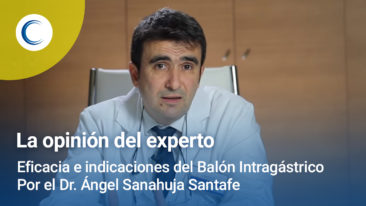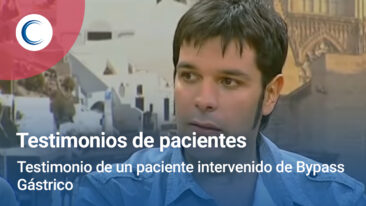Videos
Discover the audiovisual content that we offer you in Clinicas Obésitas.
The gastric banding operation is one of the most used operations to control obesity in countries like France or Australia. This is due to its simplicity, minimal surgical risk and reversibility.
The operation is performed by laparoscopy and involves placing a silicone ring in the upper part of the stomach, simply by surrounding it and closing the ring.
There is no need to cut out any organs, which makes it very safe. In addition, if desired, the band can be removed, recovering the normal anatomy.
With the gastric band, an hourglass effect is achieved, so that a small stomach is created which initially receives the food, and then gradually falls into the usual stomach, where the food is digested in the usual way.
Finally, the patient gets a feeling of satiety after eating what fits on a dessert plate, forcing the patient to stop eating. At the same time, it is gradually emptied, so that after two or two and a half hours, the patient is hungry again. It forces the patient to select the right foods for good nutrition and to eat five times a day.
The gastric band can be regulated by means of a small internal chamber that it has and that is communicated with a valve. When it swells, the light is reduced, slowing down the exit of food and prolonging the sensation of satiety.
A first swelling is always done 6 weeks after the operation, and the following ones depend on each patient. When it stops losing weight it swells a little, most often two or three swellings, and it is never touched again.
The swelling of the band is done in the radiology room of the hospital, by puncturing the small valve, which in the operation is left under the skin and fat next to the right ribs. It cannot be seen, touched or disturbed. No admission or anesthesia is required.
The swelling lasts 10 minutes and the patient returns to normal life.
The weight loss of our patients operated with this technique is 50% of the excess weight and occurs between 8 and 24 months after the operation.
See more details on our website.
Gastric banding treatment explained
Lap Band, TreatmentsGastric banding: description of the operation performed by laparoscopic surgery.
The gastric banding operation is one of the most used operations to control obesity in countries like France or Australia. This is due to its simplicity, minimal surgical risk and reversibility.
The operation is performed by laparoscopy and involves placing a silicone ring in the upper part of the stomach, simply by surrounding it and closing the ring.
There is no need to cut out any organs, which makes it very safe. In addition, if desired, the band can be removed, recovering the normal anatomy.
With the gastric band, an hourglass effect is achieved, so that a small stomach is created which initially receives the food, and then gradually falls into the usual stomach, where the food is digested in the usual way.
Finally, the patient gets a feeling of satiety after eating what fits on a dessert plate, forcing the patient to stop eating. At the same time, it is gradually emptied, so that after two or two and a half hours, the patient is hungry again. It forces the patient to select the right foods for good nutrition and to eat five times a day.
The gastric band can be regulated by means of a small internal chamber that it has and that is communicated with a valve. When it swells, the light is reduced, slowing down the exit of food and prolonging the sensation of satiety.
A first swelling is always done 6 weeks after the operation, and the following ones depend on each patient. When it stops losing weight it swells a little, most often two or three swellings, and it is never touched again.
The swelling of the band is done in the radiology room of the hospital, by puncturing the small valve, which in the operation is left under the skin and fat next to the right ribs. It cannot be seen, touched or disturbed. No admission or anesthesia is required.
The swelling lasts 10 minutes and the patient returns to normal life.
The weight loss of our patients operated with this technique is 50% of the excess weight and occurs between 8 and 24 months after the operation.
See more details on our website.

























